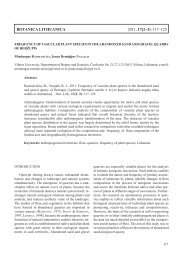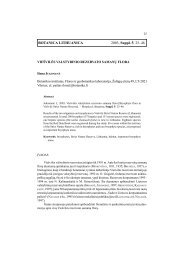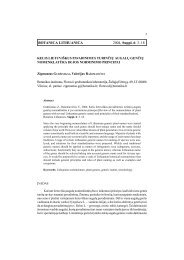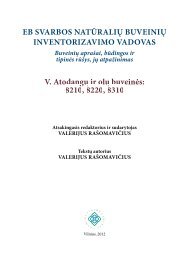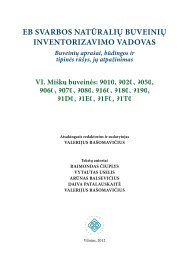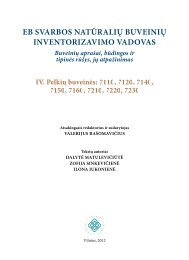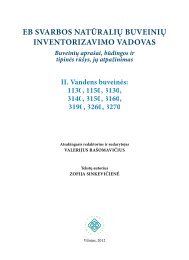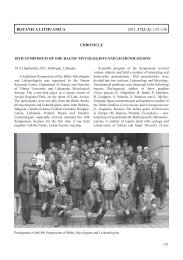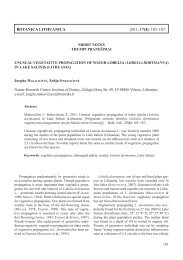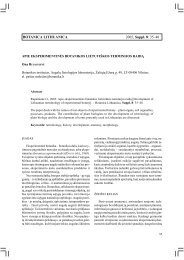FUNGI AND LICHENS IN THE BALTICS AND BEYOND XVIII ...
FUNGI AND LICHENS IN THE BALTICS AND BEYOND XVIII ...
FUNGI AND LICHENS IN THE BALTICS AND BEYOND XVIII ...
Create successful ePaper yourself
Turn your PDF publications into a flip-book with our unique Google optimized e-Paper software.
different fungal species of the same genus can infect the same host. Thus both Phomopsis<br />
vaccinii and P. conorum can infect Vaccinium spp. Phylogenetic analysis revealed<br />
relationship of teleomorph species Diaporthe angelicae and asexually reproducing fungi like<br />
Phomopsis diachenii, P. foeniculi and some newly isolated Phomopsis spp. from<br />
umbeliferous crops in Bulgaria and Lithuania.<br />
PRELIM<strong>IN</strong>ARY REPORT ON DIVERSITY OF AGARICOID <strong>FUNGI</strong> <strong>IN</strong> P<strong>IN</strong>E<br />
FOREST DAMAGED BY GREAT CORMORANTS<br />
J. KASPARAVIČIUS, A. KAČERGIUS, G. ADAMONYTĖ<br />
Institute of Botany, Nature Research Centre, Žaliųjų Ežerų Str. 49, LT-08406, Vilnius,<br />
Lithuania<br />
E-mails: jonas.kasparavicius@botanika.lt, audrius.kacergius@botanika.lt,<br />
grazina.adamonyte@botanika.lt<br />
Agaricoid fungi strongly react to various factors influencing forest ecosystem,<br />
therefore they are good disturbance indicators. The aim of this study was to investigate the<br />
influence of a piscivorous bird colony on diversity of above- and below-ground agaricoid<br />
fungus complexes. The study was carried out in pine forest affected by a nesting colony of<br />
continental subspecies of great cormorants (Phalacrocorax carbo sinensis) in the Curonian<br />
Spit, Western Lithuania. Eighteen permanent study plots were established in the forest with<br />
different degree of damage. Both above- and below-ground agaricoid fungus species diversity<br />
and diversity of trophic groups was higher in the plots outside the colony. The lowest<br />
diversity of trophic groups was observed in the plots with highest nest density and in the<br />
higher elevated colony centre already abandoned by nesting birds. The depauperation of<br />
trophic group diversity in these plots was mainly at the expense of soil saprobes and<br />
mycorrhizal fungi. Notably, living ectomycorrhiza was still found in plots with high numbers<br />
of nests, provided there were still living trees present, though no fruit bodies of<br />
ectomycorrhizal species were found.<br />
Acknowledgements. Research was funded by a grant No LEK–23/2010 from the<br />
Research Council of Lithuania.<br />
CONIFER BARK AGA<strong>IN</strong>ST P<strong>IN</strong>E NEEDLE CAST DATA ABOUT CONIFER<br />
BARK EXTRACT IMPACT ON Lophodermium seditiosum MYCELIUM<br />
GROWTH in vitro<br />
R. D. ĶIESNERE, D. KĻAVIŅA*, N. ARHIPOVA, T.GAITNIEKS, O. POLIS, A. KORICA,<br />
M.DAUGAVIETIS<br />
LSFRI “Silava”, Riga Str. 111, LV-2169 Salaspils, Latvia<br />
*E-mail: darta.klavina@silava.lv<br />
Lophodermium seditiosum Minter, Staley & Millar is one of the most significant<br />
conifer pathogens in European forest nurseries and plantations. A number of chemical defence<br />
agents is widely used for disease control but it would be valuable to produce an effective<br />
biological control agent for seedling protection against L. seditiosum. Growth rate of L.<br />
seditiosum mycelia on malt agar media with addition of pine or spruce bark and needle<br />
extracts were tested in vitro. To add the extract sterile filter papers (ø 7 cm) impregnated with<br />
certain extract were used.



